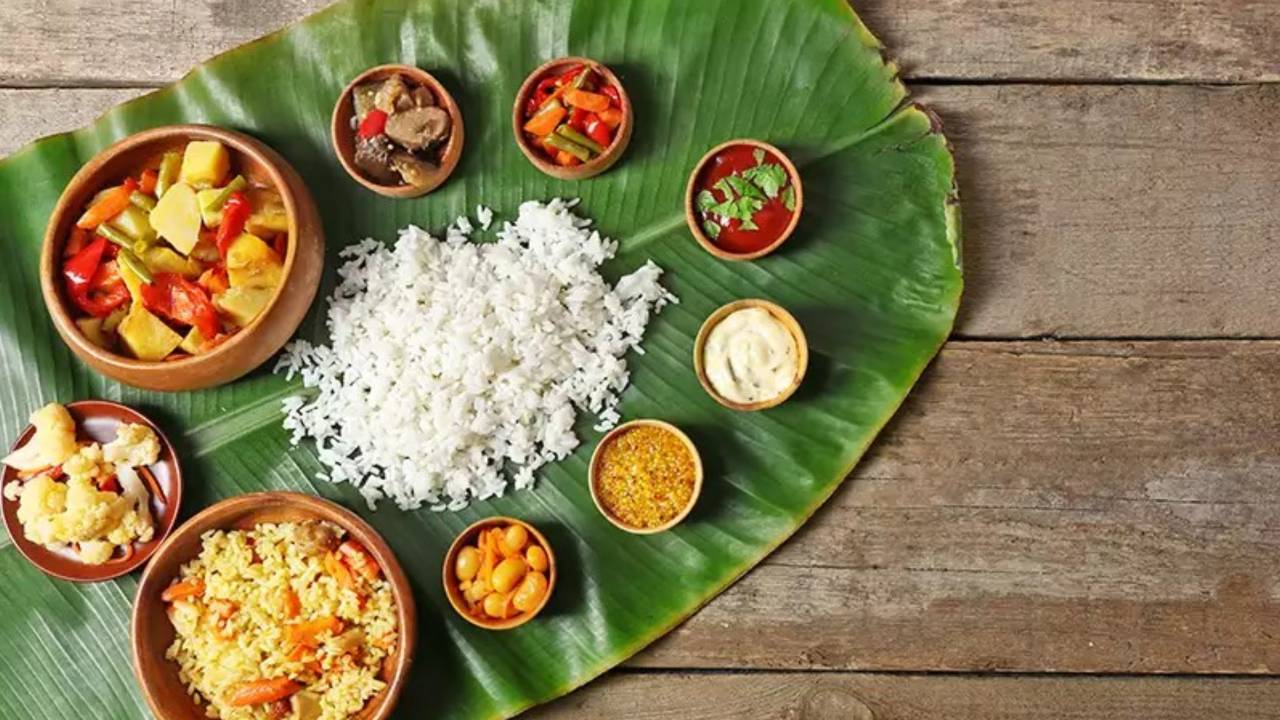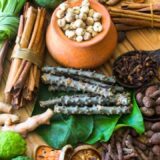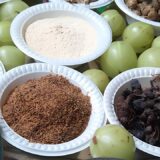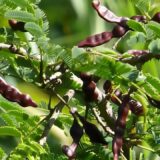The Health Benefits of Cooking with Banana Leaves
Using banana leaves for eating and steaming food is more than just a tradition in many parts of the world. From Southeast Asia to South India, the leaves of this tropical plant have played a crucial role in food preparation and presentation.Banana leaves are not only visually appealing but also possess antibacterial properties that help preserve food. 
Their large, flat surfaces make them ideal for serving meals, allowing for an aesthetically pleasing presentation while providing a natural, eco-friendly alternative to disposable plates. Additionally, when used for steaming, the leaves impart subtle flavors and aromas to the food, enhancing the overall culinary experience.
Moreover, banana leaves are rich in phytonutrients and antioxidants, contributing to the health benefits of the food they contain. This traditional practice harmonizes sustainability and nutrition, showing how ancient wisdom can inform modern culinary practices.
The Cultural Uses of Banana Leaves
Banana leaves hold significant cultural value in various regions around the world. Here are some of the prominent cultural uses:
1. Food Serving: In many Asian, African, and Latin American cultures, banana leaves are traditionally used to serve food. They are often used in communal dining settings, enhancing the experience with their vibrant color and unique aroma.
2. Cooking: Banana leaves are commonly used for wrapping and steaming food, such as rice, fish, and meat. This method is popular in cuisines like Thai, Filipino, and Indian, where the leaves infuse dishes with flavor.
3. Festivals and Ceremonies: During festivals and special occasions, banana leaves are often used to decorate dining areas or as platters for serving traditional dishes. They symbolize hospitality and abundance.
4. Religious Rituals: In some cultures, banana leaves play a role in religious ceremonies. They may be used to create offerings or as part of the altar setup, symbolizing purity and nature.
5. Traditional Medicine: In certain cultures, banana leaves are used in folk medicine for their perceived healing properties. They may be applied as wraps for treating wounds or used in herbal remedies.
6. Art and Craft: Banana leaves are also utilized in traditional crafts, including making decorative items and traditional attire. In some regions, they are woven into mats, baskets, and even roofs.
7. Eco-Friendly Practices: As a natural and biodegradable material, banana leaves are increasingly being embraced in sustainable practices, replacing plastic and synthetic materials in various cultural contexts.
In essence, banana leaves serve not just as a culinary tool but also as a symbol of cultural heritage, community, and sustainability across diverse societies.
Banana Leaves in Ayurveda
In Ayurveda, banana leaves are valued not only for their culinary uses but also for their therapeutic properties. Here are some key aspects of banana leaves in Ayurvedic practice:
- Cooling Properties: Banana leaves are considered cooling, making them beneficial for balancing Pitta dosha, which is associated with heat and inflammation. They can help soothe conditions aggravated by heat.
- Detoxification: The leaves are believed to aid in detoxification. They can help remove toxins from the body when used in food preparation or as part of a detox regimen.
- Anti-inflammatory Benefits: The leaves contain compounds that may have anti-inflammatory effects, supporting overall health and well-being.
- Antimicrobial Qualities: Banana leaves are thought to have antimicrobial properties, which can help preserve food and prevent spoilage, adding an additional layer of health benefits.
- Traditional Uses: In Ayurvedic rituals, banana leaves are often used for serving food, believed to enhance the nutritional qualities of the meal and promote digestion.
- Spiritual Significance: In some cultures, banana leaves are considered sacred and are used in religious ceremonies, symbolizing purity and abundance.
Using banana leaves according to Ayurvedic principles can contribute to both physical health and spiritual well-being.
Usage Across Different Cultures
Banana leaves play a significant role in various cultures worldwide, each incorporating them in unique ways. Here’s a look at their usage across different cultures:
1. Southeast Asia
- Thai Cuisine: Used for wrapping dishes like fish and sticky rice, banana leaves add flavor and aroma during cooking. They’re also used as serving platters for traditional meals.
- Indonesian Cuisine: In dishes like nasi liwet, rice is wrapped in banana leaves and cooked, absorbing the leaves’ essence for added taste.
2. India
- Traditional Feasts: In South Indian states like Tamil Nadu and Kerala, banana leaves are commonly used for serving meals during festivals and special occasions. Eating from banana leaves is believed to enhance digestion and health.
- Cooking: Dishes like pulao or dum biryani are often prepared in banana leaves, which helps retain moisture and infuse flavors.
3. Latin America
- Mexican Cuisine: Used to wrap foods such as tamales and barbacoa, banana leaves contribute a distinct flavor. They are often steamed or cooked with the food inside.
- Central American Dishes: In countries like Guatemala, banana leaves are used for wrapping traditional foods such as paches (potato dumplings) or cochino pibil (slow-roasted pork).
4. Caribbean
- Cooking Techniques: In the Caribbean, banana leaves are used for wrapping and cooking fish or meat. The leaves help to infuse a unique flavor and keep the food moist.
- Cultural Celebrations: They are often incorporated into festive meals, symbolizing abundance and hospitality.
5. Africa
- Culinary Uses: In many African countries, banana leaves are used to wrap foods for steaming, such as ugali or fish dishes, enhancing flavor and moisture.
- Traditional Practices: In some cultures, they are used in rituals and ceremonies, symbolizing blessings and prosperity.
6. Polynesia
- Cultural Significance: In Hawaiian and other Polynesian cultures, banana leaves are used in traditional cooking methods like imu (earth oven), where they help retain heat and moisture.
7. Philippines
- Food Presentation: Banana leaves are used as serving platters for traditional feasts, adding an aesthetic element to the meal.
- Cooking: Dishes like sinigang or lechon are sometimes wrapped in banana leaves for extra flavor during cooking.
Benefits of Using Banana Leaves for Cooking and Serving
1. Sturdy and Flexible: Banana leaves are remarkably durable, capable of holding substantial portions without tearing. Their flexibility allows for easy folding and shaping, making them ideal for wrapping and steaming various foods.
2. Generous Size: With a large surface area, banana leaves accommodate generous servings, making them perfect for family-style meals or communal dining experiences.
3. Eco-Friendly: Unlike plastic or metal plates, banana leaves are biodegradable, decomposing naturally and reducing waste. This supports sustainable practices and contributes to environmental conservation.
4. Flavor Enhancement: The natural aroma of banana leaves enhances the flavor of dishes, imparting a unique essence during cooking and serving that elevates the overall culinary experience.
5. Health Benefits: Rich in antioxidants, banana leaves can contribute to healthier meals. They are also safe for cooking hot foods, as they don’t leach harmful substances into the food.
6. Cultural Tradition: Serving food on banana leaves is a time-honored practice in many cultures, adding a unique touch to meals and celebrations while connecting diners to rich culinary heritage.
7. Aesthetic Appeal: The vibrant green color of banana leaves enhances the visual presentation of dishes, making meals more inviting and enjoyable.
In summary, banana leaves are not only practical but also enrich the culinary experience through their unique properties and cultural significance, making them an excellent choice for both cooking and serving food!
The Science Behind the Use of Banana Leaves
1. Antimicrobial Properties
One of the key reasons banana leaves have been used in food preparation is their natural antimicrobial properties. Studies show that the surface of banana leaves can help reduce bacterial growth, making them a hygienic alternative to synthetic materials.
This property not only helps keep food safe but also extends its freshness, which is particularly beneficial in traditional cooking methods where food may be stored for longer periods.
2. Heat Resistance and Durability
Banana leaves can withstand high temperatures, which is why they are often used to steam food. The natural waxy coating on the leaf ensures that it doesn’t easily burn or tear during the cooking process.
This durability makes banana leaves ideal for steaming dishes like tamales or “Puttu” (a South Indian rice cake), allowing the food to cook evenly while retaining moisture and flavor.
The use of banana leaves in cooking not only enhances the taste but also adds a beautiful presentation to the dish.
Banana Leaves and Their Impact on Flavor
Banana leaves are a culinary gem, particularly in many Asian and Latin American cuisines. Their impact on flavor is subtle but significant. Here are a few key points about how banana leaves enhance dishes:
1. Aromatic Infusion: When used as a cooking wrap, banana leaves impart a mild, earthy aroma to the food, enhancing its overall flavor without overpowering it.
2. Moisture Retention: Wrapping food in banana leaves helps retain moisture during cooking, resulting in tender and juicy dishes, whether steaming, grilling, or baking.
3. Natural Presentation: Beyond flavor, banana leaves add an appealing aesthetic to dishes. Their vibrant green color and large size make for beautiful presentations, especially in traditional settings.
4. Cultural Significance: In many cultures, the use of banana leaves is tied to tradition and ceremony, adding a layer of cultural flavor to the food experience.
5. Environmental Benefits: Using banana leaves as a cooking vessel reduces the need for disposable materials, aligning with sustainable practices.
Overall, banana leaves elevate both the taste and experience of the dishes they accompany!
Nutritional Benefits of Using Banana Leaves
Using banana leaves in cooking and serving food offers several nutritional benefits that enhance the overall healthfulness of meals. Here are some key advantages:
1. Rich in Antioxidants: Banana leaves contain various antioxidants, including flavonoids and phenolic compounds, which help combat oxidative stress in the body. These antioxidants play a crucial role in neutralizing free radicals, potentially reducing the risk of chronic diseases such as heart disease and cancer, while promoting overall vitality and well-being.
2. Phytonutrients: The leaves are rich in phytonutrients, which have been linked to various health benefits, including anti-inflammatory properties and enhanced immune function. These compounds help protect the body from infections and diseases, making them essential for maintaining good health and supporting the body’s natural defense mechanisms.
3. Natural Aroma Enhancer: When food is cooked or wrapped in banana leaves, the leaves release aromatic compounds that can stimulate appetite and enhance digestion. This natural aroma not only makes meals more enjoyable but also aids in the absorption of nutrients, ensuring that your body can make the most of the food you consume.
4. No Chemical Leaching: Unlike plastic or synthetic materials, banana leaves do not leach harmful chemicals into food, making them a safe choice for cooking and serving. This ensures that meals remain pure and free from contaminants, which is especially important for vulnerable populations like children and the elderly who may be more sensitive to chemical exposure.
5. Digestive Aid: The fibers from banana leaves may aid digestion by promoting regular bowel movements and improving gut health. When wrapped around food, they help retain moisture, leading to more tender and easily digestible meals, which can alleviate discomfort and promote a healthy digestive system.
6. Eco-Friendly: While not a direct nutritional benefit, using banana leaves promotes sustainability by reducing reliance on single-use plastics, which contribute to environmental pollution. This eco-friendly choice aligns with a holistic approach to health, considering the well-being of both individuals and the planet, thus fostering a greater sense of responsibility toward our environment.
Incorporating banana leaves into culinary practices not only enhances flavors but also contributes to a healthier lifestyle, making them a valuable addition to various dishes.
This traditional method reflects a harmonious relationship between food, health, and nature, underscoring the importance of sustainable practices in our daily lives.
How to Use Banana Leaves for Steaming Food
Using banana leaves for steaming food is a traditional cooking method that adds a subtle flavor and aroma. Here’s how to do it:
Materials Needed
- Fresh banana leaves
- Scissors or a knife
- A steamer or large pot with a lid
- Food to be steamed (e.g., fish, rice, vegetables)
Steps
Prepare the Banana Leaves:
- Cut the leaves into large pieces, about 12×12 inches, depending on the size of your food.
- Rinse the leaves under cold water to clean them.
Soften the Leaves:
- To make the leaves pliable, you can briefly heat them over an open flame or steam them for a few seconds. This prevents tearing when you fold them.
Wrap the Food:
- Place your food in the center of a banana leaf piece.
- You can add spices, herbs, or sauces for extra flavor.
- Fold the leaf over the food, creating a packet. Use toothpicks or kitchen twine to secure it if needed.
Set Up the Steamer:
- If using a bamboo steamer, line the bottom with additional banana leaves to prevent sticking.
- If using a pot, add a steaming rack or an inverted plate to elevate the packets above the water.
Steam the Food:
- Fill the pot with water, making sure it doesn’t touch the food.
- Bring the water to a boil, then reduce to a simmer.
- Place the wrapped food in the steamer, cover with a lid, and steam for the recommended time (typically 15-30 minutes, depending on the food).
Serve:
- Carefully unwrap the packets (watch out for steam!) and serve the food directly on the banana leaves for an authentic presentation.
Tips
- Use only fresh, clean banana leaves. Dried leaves may break easily.
- Experiment with different fillings and seasonings for variety.
- Banana leaves can also be used for grilling and baking!
Enjoy your flavorful steamed dishes!
FAQs
1. What are banana leaves used for?
Banana leaves are primarily used for cooking, wrapping food, and serving dishes. They are also used in traditional rituals and ceremonies in various cultures.
2. How do banana leaves enhance flavor?
Banana leaves impart a mild, earthy aroma and help retain moisture during cooking, resulting in tender and flavorful dishes.
3. Are banana leaves safe to use for cooking?
Yes, banana leaves are safe for cooking. They are non-toxic and have been used for centuries in various cuisines.
4. How do you prepare banana leaves for cooking?
To prepare banana leaves, wash them thoroughly and soften them by briefly passing them over an open flame or steaming. This makes them more pliable and easier to work with.
5. Can you eat banana leaves?
While banana leaves are not typically eaten, they can be used as a wrap for cooking food, which absorbs flavors and nutrients during the process.
6. What are the benefits of cooking and serving food on banana leaves for weight management?
Cooking and serving on banana leaves can promote healthier eating habits by encouraging the consumption of fresh, whole foods often wrapped in these leaves. The natural aroma and flavor can enhance the taste of low-calorie dishes, making them more enjoyable. Additionally, using banana leaves instead of plates may help with portion control and reduce the likelihood of overeating.
7. What is the science behind eating from banana leaves?
Eating from banana leaves is backed by several scientific principles. The leaves have antioxidant properties that may contribute to overall health. Their natural aroma can enhance the sensory experience of eating, stimulating appetite and digestion. Additionally, banana leaves are biodegradable, making them a sustainable choice for serving food.
8. What are the medicinal uses of banana leaves?
Banana leaves are traditionally used in various medicinal practices. They are believed to have anti-inflammatory and antibacterial properties, making them useful for treating wounds and infections. They are also thought to aid in digestion and detoxification when used in food preparation.
9. Are there any disadvantages to using banana leaves?
While banana leaves have many benefits, some disadvantages include the potential for tearing during handling, difficulty in finding fresh leaves in certain regions, and the possibility of allergic reactions in sensitive individuals. Additionally, they may not be suitable for all types of foods, especially those with strong flavors that could overpower the delicate taste of the leaves.
10. What are the uses and benefits of dried banana leaves?
Dried banana leaves can be used for wrapping food for storage, providing a unique flavor when used in cooking. They can also be used for crafts, such as making baskets and mats. Additionally, dried leaves can be brewed into teas that are believed to have various health benefits.
11. How do banana leaves benefit the skin?
Banana leaves are often used in traditional skincare remedies due to their anti-inflammatory and cooling properties. They can be used in poultices to soothe skin irritations or as wraps to promote healing. The leaves may also help retain moisture when applied to the skin.
12. What are the overall benefits of banana leaves?
The benefits of banana leaves include their eco-friendly nature, antioxidant properties, culinary versatility, and cultural significance. They enhance flavor, help retain moisture during cooking, and promote healthy eating habits. Additionally, they are rich in nutrients and have medicinal uses in various traditional practices.
The use of banana leaves in cooking and serving food isn’t just about tradition; it’s a practice backed by science. From their antimicrobial properties to their ability to enhance flavor, banana leaves offer a multitude of benefits.

























